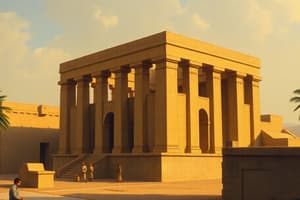Podcast
Questions and Answers
What development marked the shift from nomadic to settled lifestyles in prehistoric architecture?
What development marked the shift from nomadic to settled lifestyles in prehistoric architecture?
- Development of permanent villages
- Domestication of animals and plants (correct)
- Use of advanced building materials
- Construction of megaliths
Which of the following structures is correctly matched with its cultural origin?
Which of the following structures is correctly matched with its cultural origin?
- Igloo - Greenland
- Wigwam - European settlers
- Trullo - Alaska
- Tipi - Native American (correct)
Which type of prehistoric dwelling is characterized by its conical vaulted roof?
Which type of prehistoric dwelling is characterized by its conical vaulted roof?
- Hogan
- Wigwam
- Beehive hut
- Trullo (correct)
What significant characteristic did early human settlements, like those in Mesopotamia, primarily depend on?
What significant characteristic did early human settlements, like those in Mesopotamia, primarily depend on?
In which area is the Lascaux Cave, known for its prehistoric wall paintings, located?
In which area is the Lascaux Cave, known for its prehistoric wall paintings, located?
Which type of structure was primarily built as a response to climate, local materials, and hunting patterns in prehistoric times?
Which type of structure was primarily built as a response to climate, local materials, and hunting patterns in prehistoric times?
What architectural feature is characteristic of Egyptian architecture from 3000 B.C. to 200 A.D.?
What architectural feature is characteristic of Egyptian architecture from 3000 B.C. to 200 A.D.?
What was a primary focus of the construction of Egyptian funerary monuments?
What was a primary focus of the construction of Egyptian funerary monuments?
Which prehistoric culture is associated with the dwelling type called 'Hogan'?
Which prehistoric culture is associated with the dwelling type called 'Hogan'?
What was the primary function of megaliths in ancient architectural practices?
What was the primary function of megaliths in ancient architectural practices?
Which structure served as a tomb for the nobility or royal family in ancient Egypt?
Which structure served as a tomb for the nobility or royal family in ancient Egypt?
What is the purpose of a mortuary temple in ancient Egyptian architecture?
What is the purpose of a mortuary temple in ancient Egyptian architecture?
Which Egyptian god is associated with motherhood and protection?
Which Egyptian god is associated with motherhood and protection?
What geographical feature significantly benefited ancient Egypt's agriculture?
What geographical feature significantly benefited ancient Egypt's agriculture?
How were the walls of ancient Egyptian tombs typically decorated?
How were the walls of ancient Egyptian tombs typically decorated?
What is a key distinction between a cult temple and a mortuary temple in ancient Egypt?
What is a key distinction between a cult temple and a mortuary temple in ancient Egypt?
What is the primary deity associated with the Karnak Temple Complex during the New Kingdom?
What is the primary deity associated with the Karnak Temple Complex during the New Kingdom?
Which of the following is a key architectural feature found in the Karnak Temple Complex?
Which of the following is a key architectural feature found in the Karnak Temple Complex?
What characterized the Avenue of Sphinxes leading to the Karnak Temple Complex?
What characterized the Avenue of Sphinxes leading to the Karnak Temple Complex?
Which type of sphinx has a human head and a lion body?
Which type of sphinx has a human head and a lion body?
What is the purpose of the obelisk in ancient Egypt?
What is the purpose of the obelisk in ancient Egypt?
Which structure is NOT part of the Karnak Temple Complex?
Which structure is NOT part of the Karnak Temple Complex?
The holy of the holies within the Karnak Temple Complex is primarily used for what purpose?
The holy of the holies within the Karnak Temple Complex is primarily used for what purpose?
What does the term 'pylon' refer to in the context of the Karnak Temple Complex?
What does the term 'pylon' refer to in the context of the Karnak Temple Complex?
Who was the architect responsible for the construction of the Pyramid of Djoser?
Who was the architect responsible for the construction of the Pyramid of Djoser?
What was the original design intention for the height of the Pyramid of Sneferu?
What was the original design intention for the height of the Pyramid of Sneferu?
What is unique about the Bent Pyramid in comparison to traditional pyramids?
What is unique about the Bent Pyramid in comparison to traditional pyramids?
Which pyramid is known as the first true pyramid completed in Egypt?
Which pyramid is known as the first true pyramid completed in Egypt?
What architectural feature distinguishes the Great Pyramid of Khufu?
What architectural feature distinguishes the Great Pyramid of Khufu?
What part of a pyramid complex serves as a place of worship for a deceased king or queen?
What part of a pyramid complex serves as a place of worship for a deceased king or queen?
What was added to the design of the Pyramid of Sneferu to address structural issues?
What was added to the design of the Pyramid of Sneferu to address structural issues?
Which of the following accurately describes the Pyramid of Djoser?
Which of the following accurately describes the Pyramid of Djoser?
What is the primary function of the valley temple in an ancient Egyptian pyramid complex?
What is the primary function of the valley temple in an ancient Egyptian pyramid complex?
Which structure is specifically a part of a pyramid complex used for ceremonial routes?
Which structure is specifically a part of a pyramid complex used for ceremonial routes?
How is the pyramid temple related to the pyramid complex?
How is the pyramid temple related to the pyramid complex?
Which of the following is NOT a component of a pyramid complex?
Which of the following is NOT a component of a pyramid complex?
What distinguishes the queen's pyramid from other pyramids?
What distinguishes the queen's pyramid from other pyramids?
Which of the following structures is found at the foot of a pyramid?
Which of the following structures is found at the foot of a pyramid?
What is the purpose of the sphinx within the pyramid complex?
What is the purpose of the sphinx within the pyramid complex?
Which of these pyramids was built for Khufu?
Which of these pyramids was built for Khufu?
Flashcards are hidden until you start studying
Study Notes
Exam Subject Weights
- 30%: History and theory of architecture; principles of planning; architectural practice
- 30%: Structural design; building materials and construction; utilities
- 40%: Architectural design and site planning
Course Outline
- MODULE 1: Prehistoric and Ancient Architecture
- MODULE 2: Classical Architecture and the Western Succession
- MODULE 3: Architecture in Asia and the Pacific Region
- MODULE 4: Architecture in the Philippines
Module 1 Overview
- Covers Prehistoric Architecture, Mesopotamian Architecture (Sumerian, Babylonian, Assyrian, Persian), Egyptian Architecture, and Minoan Architecture.
Prehistoric Architecture
- Transitioned from nomadic hunting to settled farming and hunting, leading to village formations near resources like caves or water bodies.
- Rock caves served as early human settlements, exemplified by Lascaux Cave in France, dated c. 13,000-8,500 BCE.
- Primitive shelters reflected climatic conditions and available materials, requiring minimal investment in construction time and resources.
- Housing types included Tipis, Beehive huts, Trullos, Wigwams, Hogans, and Igloos, adapted for portable and local living conditions.
- Religious structures connected communities through mortuary sites and communal goddess rituals, often marked by megaliths.
Egyptian Architecture (3000 B.C.-200 A.D.)
- Distinguished by axial planning of monumental tombs and temples, characterized by trabeated construction and elaborately carved designs.
- Built for eternity and afterlife, featuring funerary monuments and temples central to religious beliefs.
- Harnessed the Nile's resources for trade, communication, and agriculture, boosting societal development.
Religious Structures
- Mastaba: A rectangular tomb for high-status individuals, made of mud brick with an internal shaft leading to burial chambers.
- Two types of temples: Cult temples for deities and Mortuary temples for offerings to deceased rulers, emphasizing the importance of gods like Ra, Osiris, and Isis.
Key Architectural Features
- Karnak Temple Complex in Luxor, dedicated to Amun-Re, includes multiple temples built during the New Kingdom.
- Sphinx: Mythical creature symbolizing protection, often guarding tombs and temples.
- Obelisk: Monumental stone column inscribed with hieroglyphs, typically erected in pairs at temple entrances.
Notable Structures
- Pyramid of Djoser: The first pyramid built by Imhotep, originally a mastaba, enhanced into a step pyramid.
- Bent Pyramid: A unique design reflecting construction challenges faced by builders, altering the slope angle mid-construction.
- Pyramids of Giza: Grand structures, aligned with cardinal points, exemplifying the pinnacle of Egyptian architectural engineering with precise measurements.
Pyramid Complex Components
- Mortuary Temple: Associated with pyramids for the worship of deceased rulers.
- Valley Temple: Functioned as the preparation site for Pharaohs before their burial.
- Pyramid Causeway: A ceremonial route linking valley and mortuary temples.
Additional Notes
- The Great Pyramid of Khufu stands as the tallest pyramid at 480 feet, constructed from local limestone.
- Egyptian architectural innovations also included mortuary temples, pyramid complexes, and precise orientation practices in construction.
Studying That Suits You
Use AI to generate personalized quizzes and flashcards to suit your learning preferences.




